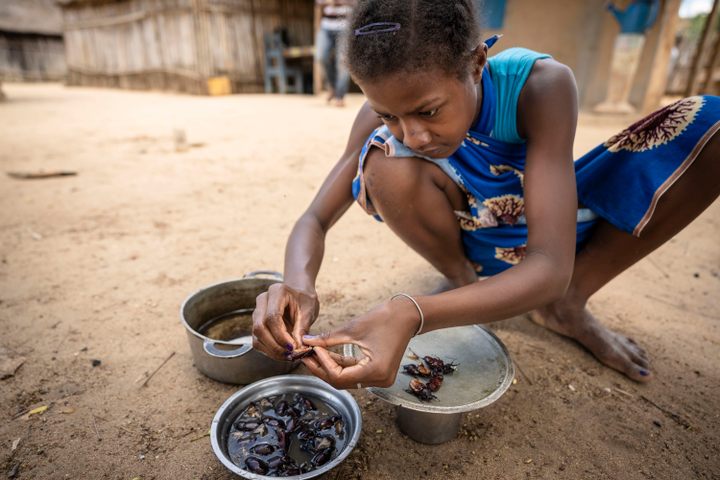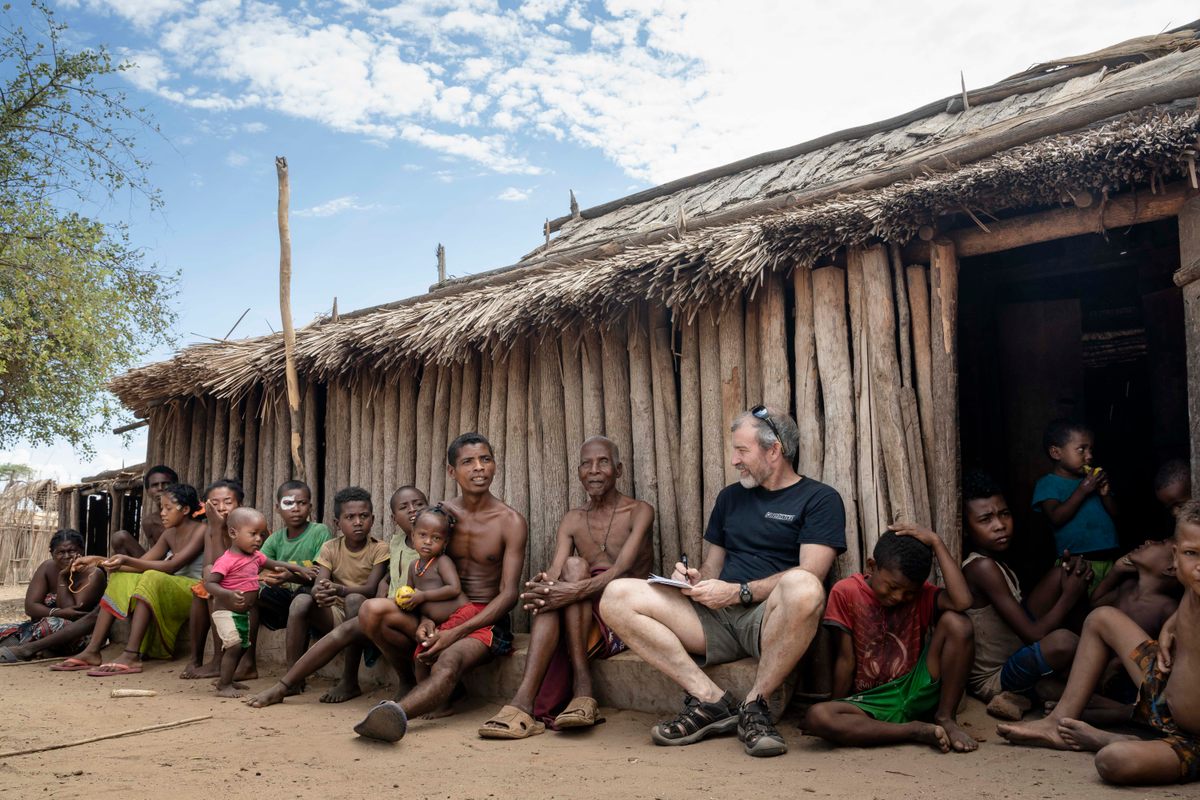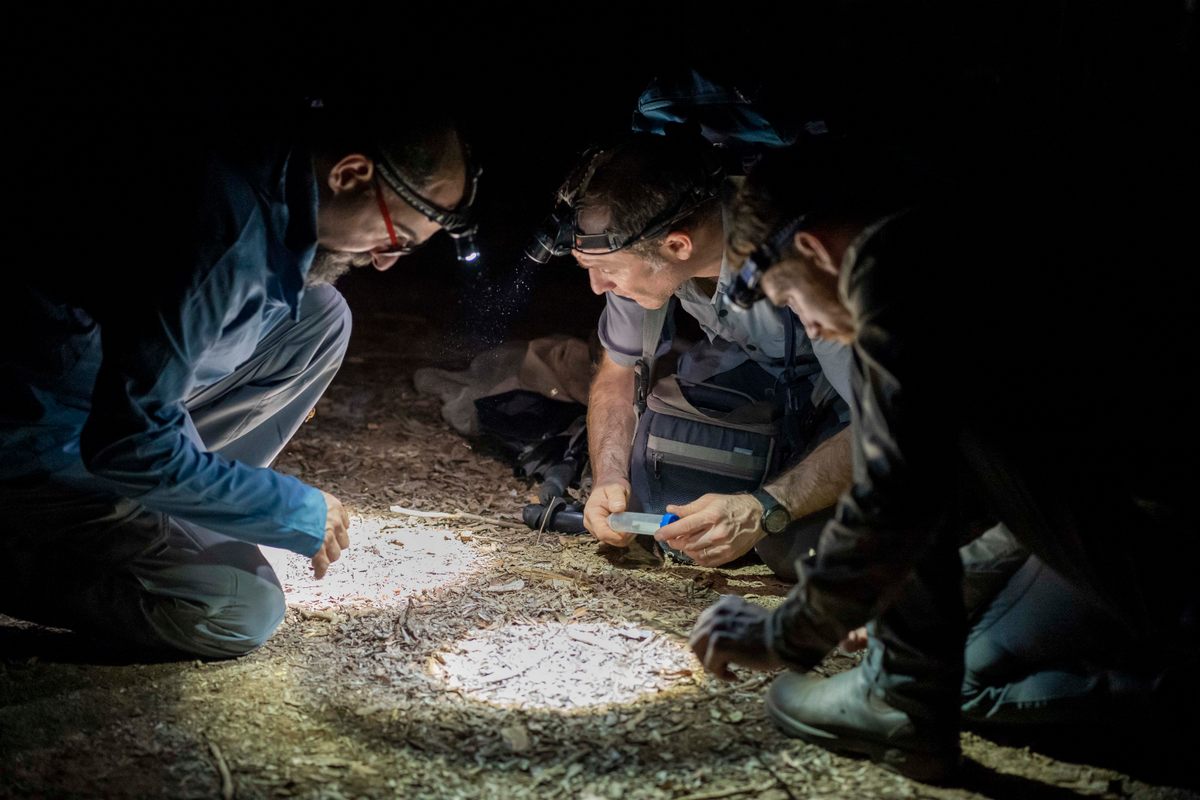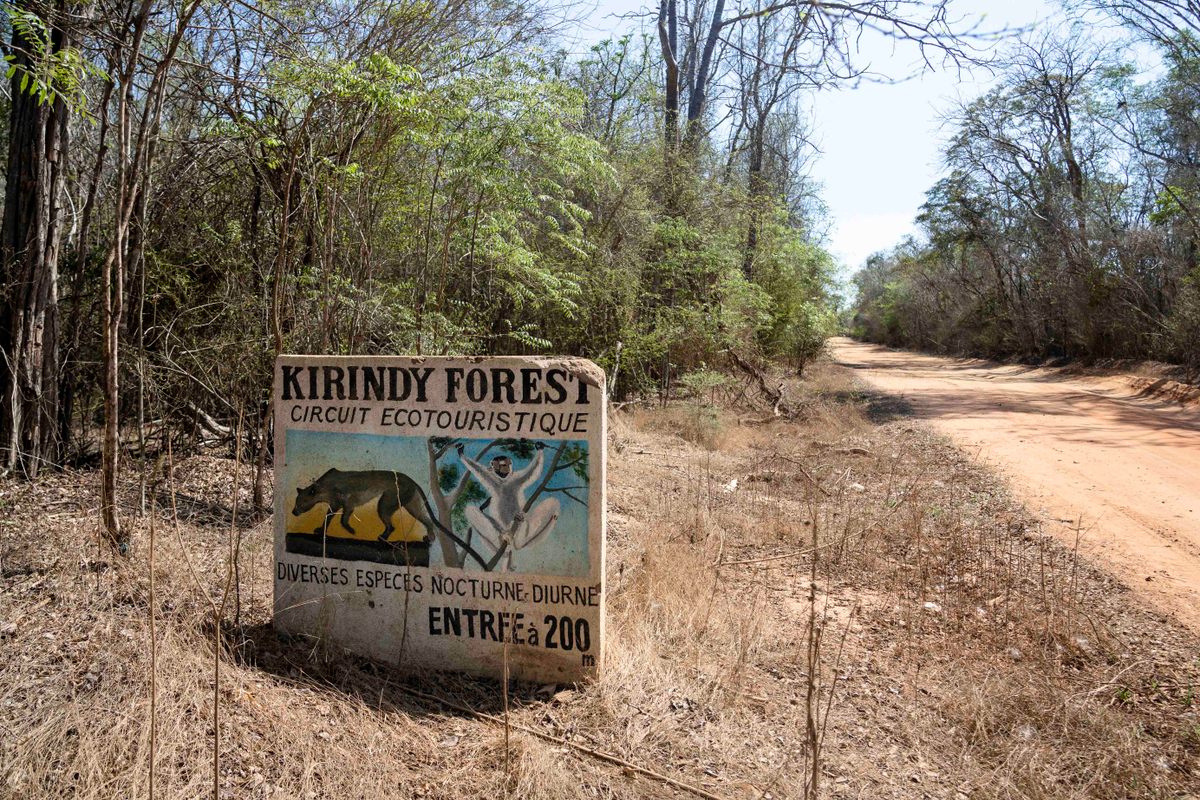

To Save Madagascar’s Wildlife, an Entomologist Is Helping Revive a Bug-Based Cuisine
Local insect farms could save lemurs, baobabs, and more.
This story originally appeared on bioGraphic and is published here with permission.
As a young boy, Julien Jean Donehil would often go out searching for insects. For kids his age living on the dry west coast of Madagascar, the pastime doubles as both a game and a snack. Crickets and cicadas can be found amid the leaf litter, their high-pitched songs a dead giveaway. During the summer rainy season, locusts appear in abundance on the stems of corn and cassava plants. Always the tastiest, Donehil tells me, are rhinoceros beetles (Oryctes nasicornis), which clamber around the corrals of zebu cattle. To a young boy, the beetle’s thick exoskeleton and curled, weaponlike horns are like those of an action figure. Donehil and his friends would often stage mock battles, and then bring their quarry back home. There, after first removing the insects’ wings, they would roast the protein-packed treats in their mothers’ cooking fires.
Back then, in the early 2000s, Donehil and the other children in his village, Beroboka, never went hungry. There was always arable land to grow peanuts and maize, and grass for zebu to graze. A vast succulent woodland forest, unique in Madagascar and the world, surrounded the village, stretching for miles. Towered over by giant baobab trees (Adansonia grandidieri), it was home to creatures found nowhere else, like the Madame Berthe’s mouse lemur (Microcebus berthae), the world’s smallest primate, and a giant rat (Hypogeomys antimena) that hops around like a kangaroo. Panther-like fossas (Cryptoprocta ferox) and hedgehog tenrecs (Echinops telfairi) and flying foxes (Pteropus rufus) frequently wandered past or flew over his home. “It was beautiful,” he recalls.
Donehil is now 18 and no longer forages for insects as younger boys still do. Beroboka is no longer the village it once was, either. Around eight years ago, Donehil says, the neighboring forest started to disappear. The destruction accelerated, through slash-and-burn practices, whereby land is cleared to make way for crops, the soil becomes degraded, and then more forest has to be destroyed. Around the same time, the human population was also swelling as migrants from Androy, the southernmost region of Madagascar, arrived. Fleeing a years-long drought and desperate, these pastoral people were often offered cash by powerful entities to plant corn on any piece of land they could set a match to.


Immigration and murky agrobusiness dealings have now laid waste to vast swaths of the unique, deciduous dry forest that blankets Madagascar’s west coast, driving its biodiversity toward the brink. Conservation groups have organized raids to catch illegal loggers and destroy their camps, but limited resources make the effort halting; plumes of grey smoke still mark the sky daily. The outlook is grim: It’s predicted that by 2025, the Menabe Antimena Protected Area, an 812-square-mile tract that includes villages like Beroboka, will have lost 80 percent of its forest cover.
“This region really has no hope unless something different happens,” says Brian Fisher, an entomologist at the California Academy of Sciences, as we climb into our S.U.V. to leave Beroboka. Out the window, the landscape has an almost post-apocalyptic quality: barren fields of charred earth stretch out to the horizon, interrupted only by sporadic fire-resistant baobab trees that stand like starved survivors. Fisher, who has been coming to Madagascar for 25 years to study ants, has witnessed the island lose a staggering amount of its unique biodiversity to the forces of population growth, deforestation, and malnutrition, as desperate locals turn to the forest for food. Recently, he launched an audacious plan to reverse the tide of destruction. Boosting a local tradition of consuming insects, he hopes, might offer a nutritious substitute for wild animals. For impoverished people, farmed insects could also provide a viable source of income.
Fisher has had some initial success in the jungles of eastern Madagascar, where a pilot project to boost the numbers of native, edible insects seems to have reduced pressure on lemurs and other hunted animals. But the destruction he now sees along the island’s west coast is on a different scale. “I feel like I’m absorbing the severity of the situation here,” he says. But if insect farming can work here, he figures, he can make it work anywhere.

In the popular imagination, Madagascar exists as a cartoon version of itself, a land of staggering biological richness. The world’s oldest and fourth largest island, it was once wedged between Africa and India, part of the supercontinent Gondwana, an ancient landmass that began to fragment some 180 million years ago. Madagascar then splintered off with India and drifted northeastward, until around 80 million years ago, it was left behind as India continued its march toward the collision with Asia that would form the Himalayas. This geological history of separation, as well as the island’s varied topography and climates—ranging from tropical mountain valleys to plateaus to coastline to arid deserts—allowed life to evolve, and diversify, in isolated pockets. Eighty-five percent of Madagascar’s plants, nearly all of its reptiles, and half of its birds exist nowhere else. When humans first arrived some 10,000 years ago, they’d have found an island containing five percent of the world’s biodiversity, including lemurs the size of gorillas and a flightless elephant bird that stood more than nine feet tall.
Those megafauna have since gone extinct, but for biologists like Fisher, Madagascar remains a treasure trove. “You never know what you’re going to find until you get to a patch of forest,” he says. “And every time you get to a new patch, you always find something unique there.” Little was known about Madagascar’s ants when Fisher first began studying them in 1993 as a PhD student. His often swashbuckling fieldwork has led him to some of the island’s most remote corners, where he’s been able to describe more than 450 new species of ants. Over time, though, Fisher encountered a disturbing pattern. “You go back to an area where you were just three years earlier and discovered something dramatically new, and find the whole forest is gone,” he says. “Not just degraded. It’s leveled—there’s not a tree left on the mountain. And you’re like, ‘Oh, there goes that species.’ After a while, it is kind of shocking. You wonder, how many times that’s happening to forest we haven’t even been to yet.”
It’s been happening at an astonishing pace. Since the early 1950s, deforestation has reduced Madagascar’s forest cover by nearly half. In 2018, the island lost a higher proportion of its primary rainforest than any other tropical country, a consequence of slash-and-burn agriculture, as well as pockets of sapphire and nickel mining. The familiar threats of climate change, invasive species, overharvesting, and habitat loss and fragmentation have also exacted a heavy toll: Madagascar’s endemic lemurs are now the most threatened group of primates on Earth, and nearly all of its species (94 percent) are at risk of extinction because of habitat loss and unsustainable hunting.

In 2013, Fisher caught wind of an influential report published by the Food and Agricultural Organization (FAO), which put forward a provocative approach to addressing the world’s looming environmental and humanitarian crises. By 2050, the report stated, 9 billion people will inhabit the planet. To meet this future demand, food production would need to almost double from its current rate. Farmland is scarce, and continuing to expand it is neither viable nor sustainable. Oceans are already overfished. Climate change, and related water shortages, will likely impact agriculture dramatically—and there are already nearly 1 billion chronically hungry people worldwide. To meet these challenges, the FAO report concluded, “we need to find new ways of growing food.”
Edible insects, it argued, present a sensible solution. More than 1,900 different species of insects are already consumed worldwide, mostly across Africa, Latin America, and Asia. Insects are made up of as much as 65 percent protein; studies have found that grasshoppers, crickets, and mealworms contain significantly higher sources of minerals such as iron, zinc, copper, and magnesium than sirloin does. Pound for pound, insects require less land, less water, and less feed than other animals. And they also produce less waste than livestock, including fewer greenhouse gases.
It’s not hard to see Madagascar as a microcosm of the world that the FAO envisions. The country ranks in the bottom 15 percent of the UN’s Human Development Index, and is one of the least food-secure nations in the world. More than 90 percent of Madagascar’s population lives below the international poverty line, and it is one of the few countries where the rate is increasing. Madagascar, as a whole, has the world’s fourth highest rate of chronic malnutrition: Almost half of all Malagasy children under five are malnourished. That constant, desperate need for food is what leads people into the forest to hunt for bushmeat, a factor widely recognized as a major contributor to global biodiversity loss.
As he crisscrossed the island documenting ants, Fisher began to wonder whether he was devoting his time wisely. “All of this work, and I have saved not a single tree in Madagascar,” he tells me. “And if I continue doing this, pretty soon I’ll just be documenting what was once in Madagascar. So, I challenged myself—it’s time not to be on the sidelines. What could I possibly do to participate in conservation?”

Fisher knew that the Malagasy ate insects—he’d seen them sold at local markets across the island. As he dug deeper, he read that as early as 1617, missionaries and other visitors to Madagascar attested to the natives’ taste for Orthoptera—the classification that includes grasshoppers, locusts, crickets, and katydids. Periodic locust outbreaks might devastate a crop, but could also provide a valuable source of nutrition, especially between harvests. A preparation that involved soaking dried locusts for half an hour in saltwater and then frying them in fat “appeared on the tables of princes.” It’s said that Queen Ranavalona II, who reigned Madagascar in the 19th century, frequently dispatched female servants to the countryside to collect locusts for her.
Fisher assembled a working group, dubbed Insects and People of the Southwest Indian Ocean (IPSIO), comprised of insect researchers and regional conservation and humanitarian organizations. The group’s aim was to explore ways to leverage Madagascar’s edible-insect tradition as a way of conserving its biodiversity. Although industry groups estimate edible insects to be a 600-million-dollar business worldwide, most are used in pet food, livestock feed, and fish feed for aquaculture.
With this new objective in mind, Fisher reached out to Entomo Farms, North America’s largest producer of human-grade insects, based in Ontario. The company’s ground cricket powders supply a burgeoning market of insect-based protein bars, smoothies, chips, crackers, pasta, hot dogs, and pet treats. Entomo’s co-founder, Darren Goldin, considered Fisher’s idea a worthy “passion project,” he tells me, and helped design a production facility in Antananarivo, Madagascar’s capital.
Crickets, it turns out, are an exemplary food to farm. They grow quickly—six weeks to full maturity—and thrive in confined spaces. They require few inputs—a bit of drinking water and grain feed is all—and as cold-blooded creatures, they don’t expend energy regulating their core temperature, as most farm animals do; half of what a chicken eats goes toward warming its body. A recent study even suggests that in addition to high protein levels, crickets contain chitin and other fibers that may improve gut health, as well as reduce systemic inflammation. There are ancillary agriculture benefits, too: Dry cricket frass (poop), a byproduct, is a useful fertilizer.
“In the end, nobody cares that it’s cricket powder,” Fisher said recently. “They eat it because it tastes good.” He was speaking one afternoon last November to a group of NGOs with food assistance programs in Madagascar, showing them his modest production facility, Valala Farms. The operation occupies part of the three-story insect research center that Fisher established 15 years ago on a hilly plot above the city’s zoo and botanical gardens. (There are plans to break ground on an expansive, 23,000-square-foot facility later this year on adjacent land donated to him by the country’s education ministry.)
On this occasion, the young Malagasy staff had prepared a spread of cricket hors d’oeuvres: skewers of honey-roasted whole insects, a yogurt dip flecked with ground powder. Fisher first led the visitors into a humid room that sounded discomfitingly like a plague—the din of 200,000 chirping crickets confined inside two rows of mesh-covered enclosures grouped by life stage.
The insects skittered across stacks of egg crates meant to provide them ample surface area and airflow, occasionally gathering at small trays of water and chicken feed. Once they reach maturity and mate, the females use a pair of barbed ovipositors to lay their eggs into moist cotton balls (meant to mimic sand). The impregnated cotton then gets transplanted to a separate incubation room, kept at 31 degrees Celsius (88 degrees Fahrenheit), and the mature adults are euthanized by carbon dioxide and collected. In an adjacent kitchen, the “harvested” crickets are washed, ground into a moist slurry using a meat grinder, dehydrated on baking sheets, and milled into a fine brown powder that smells something like roasted sunflower seeds.

With their deep pockets and wide reach across the country, Fisher views humanitarian organizations as the primary customers for cricket powder. A successful pilot project with Catholic Relief Services (CRS) demonstrated its potential to tackle malnutrition. CRS introduced cricket powder to elementary and middle school children in Antananarivo through a school lunch program, where it was sprinkled on top of traditional Malagasy meals like rice and beans. (Fisher’s team has also conducted studies in Antananarivo’s schools to gauge student perceptions of eating insects.) In the drought-stricken region of Androy, Madagascar’s impoverished south, Catholic sisters there run a tuberculosis clinic and fed the powder with meals to patients suffering from appetite and weight loss as a consequence of their infections. After just two weeks, all of the patients had gained weight, a critical factor in recovery; within the first three weeks, one had added more than five pounds. “We’re super excited about this work,” CRS’s Tanja Englberger tells me. “When they don’t add it, [patients] ask, ‘Where is the cricket powder?” CRS is now extending the project to another 10 clinics across Madagascar, and may launch a series of nutritional studies.
To help reverse the loss of Madagascar’s biodiversity though, Fisher needs to bring the project closer to critical areas. A few years ago on an Air France flight from Paris to Antananarivo—the type of scene where a surprising amount of networking occurs—he struck up a conversation with Cortni Borgerson, an anthropologist at New Jersey’s Montclair State University. For 15 years, Borgerson has looked at subsistence hunting practices in Madagascar, particularly around Masoala National Park, a species-rich rainforest on the eastern coast. The largest of the country’s protected areas, Masoala is seen as a likely last stronghold of intact habitat. Among people living there, poverty is nearly universal, higher than national averages. One-quarter of the population is anemic. Borgerson’s surveys have found that as much as 75 percent of all meat eaten in some communities comes from forest animals. Child malnutrition rates are higher in households that hunt lemurs, suggesting that when they have little else to eat, families turn to bushmeat.
During the rainy season, natives of the Masoala Peninsula take delight in an endemic Fulgorid planthopper (Zanna madagascariensis, or “sakondry” in Malagasy) that feeds on the sap of wild lima beans and related plants. Locals pick them off in large clusters like berries, rinse them twice, and fry the fatty insect whole without even the need for oil. The taste is delicious, Borgerson says—like bacon. She’d long known of this food practice, and so had Fisher: He’d first photographed sakondry 20 years earlier in the island’s western dry forests. But how long did the insects live? What did they eat? When do females lay eggs? Science didn’t have answers at the time, but Borgerson and Fisher felt the sakondry held great promise for addressing regional nutritional deficiencies and the interrelated conservation issues. They’ve received a three-year grant from IUCN’s Save Our Species initiative to test sakondry farming methods.
Their pilot project is set in six of the Masoala’s most remote jungle communities, where wildlife makes up a large proportion of the diet. “Find the last village on the map, and we are like four days beyond that,” Borgerson says. The communities range from 10 to 200 households; participation is voluntary. The researchers first distributed bean plant seeds, and established a sharing program. Within the first three months, one community grew around 500 lima bean plants. “It just took off,” Borgerson tells me. There are now 4,200 plants growing across all test sites—more food for the humans, and an abundance of hosts for sakondry. (The insects drink the sap-like phloem of the plant without significantly impacting bean production.) It’s a win-win, Borgerson says, “because then you get both products.” At last estimate, 52,000 individual sakondry had taken up residence, and insect consumption has increased by 400 percent of what it had been before the project began. Borgerson and Fisher’s aim had been to produce enough insect meat to replace lemur meat within three years, a goal they reached within the first eight months of the project. “It went way better than expected,” Borgerson says. “And I get at least eight Facebook messages from random communities being like, ‘Hey, when are you going to come bring sakondry here?’”
Still, crucial questions remain. Most importantly, is it actually changing any behavior? Preliminary results show that the farming has significantly positively affected child nutrition, food security, and the sustainability of hunting, according to Borgenson. There’s now simply more food, she says, available at the times when people might typically hunt. Borgerson notes that the project is having the greatest impact on women and children, who’ve been seen grabbing sakondry by the fistful. In theory, as their nutrition improves, it ought to give men of the household fewer incentives to hunt lemurs.

To reach the Menabe Antimena protected area, a patchwork of dry forest and mangrove reserves on Madagascar’s west coast, I flew with Fisher one hour from Antananarivo to the seaside town of Morondova, and then drove another two hours north by car along a rutted, red-sand road. The route passed by the Avenue of the Baobabs, a photogenic grove of trees that is among the island’s top tourist attractions. We passed boys sitting atop zebu carts loaded with sacks of rice and peanuts, and villages where women squatted in the shade, selling corn. Crammed in the back seat was Entomo’s Darren Goldin and the company’s farm manager, Aran Hinton, there to help Fisher evaluate the feasibility of establishing a small-scale farm project in a local village. Also with us was Sylvain Hugel, a specialist in crickets who would be able to determine which species might work best. All had joined Fisher field expeditions before. “He’s the most experienced field guy I’ve ever met,” Hugel tells me. “The amount of stories he could tell you about problems in the field—it’s just crazy, you could write a book.”
These stories include surviving all manner of tropical diseases, from malaria (“a recurring theme in my life,” Fisher says) to leishmaniasis, which bore a hole in his leg, and loiasis, in which worms squiggled across his eyeballs. Fisher once narrowly escaped an armed group in the Central African Republic, and was forced to improvise in the Congolese jungle after local warriors his team had hired as guides disappeared with their tents and food. Vehicle breakdowns, equipment malfunctions, roadblocks, and getting lost were familiar occupational hazards. By comparison, this trip was a cakewalk. We planned to sleep in beds that night.
We turned off the road at the entrance to Kirindy Forest, a privately managed reserve with a small research center and tourist bungalows. The dry deciduous forest there is home to seven species of lemur as well as the fossa, Madagascar’s largest predator; one wandered by the reception desk not long after we arrived. Skinks and lizards rustled the dried leaves lining the footpaths between bungalows. As night fell, Hugel grabbed his headlamp and a butterfly net, and with the guys from Entomo Farms, set out to collect specimens.
Crickets reveal themselves by their songs, unique to each species. Males produce sound by rubbing the serrated edge of one forewing against the sharp-edged bottom of the other, a movement known as stridulation. These chirps are meant to attract mature females that pick up the sound through timpana membranes on their forelegs. The females seem to find the calls irresistible. Human cultures do, too. Across Asia, crickets have long been kept as pets, and in China, where the insect symbolizes luck and prosperity, imperial concubines are said to have placed crickets in small gold cages on their bedside to delight in their songs.

“There are many species here,” Hugel remarked, noting a variety of calls. He crouched down above the leaf litter in one patch, hovering the net in his hand. With one swift motion, he slammed the hoop flat against the ground, entrapping a cricket. He then placed the specimen inside a vial along with some leafy matter, which he says relaxes them. Any candidate for potential farming must be native to the area, Hugel explained—in part so as not to disturb the native ecology should any escape. But it was also important to select a species that could be reared year-round, so he looked for both juveniles and adults of a single species as evidence that their life cycle would span across rainy and dry seasons.
Fisher had arranged with a local USAID-funded NGO project, Mikajy, for the team to be shown three villages that stood just outside the protected forest. Each were identified as potential sites to introduce cricket farming. Over a breakfast of rice porridge and French bread the next morning, Fisher explained some of the challenges the team faced. “Community work is far more complicated than commercial business models,” he says. “There’s not one model that can be easily applied from one village to the next. And there’s a 100-percent resistance to change. First, we have to identify the issues of concern for that village. We also have to understand its structure. Is it an immigrant village, or a traditional village? Do they farm, and if so, where? If they don’t farm at all, that means they’re going into the forest.”
In the first village, Kirindy, the team met with a thin, shirtless man in his 30s, said to be its chief, outside a home constructed with vertical tree trunks and thatched roofing. As a couple dozen family members gathered around—men on one side, women and toddlers on the other—Fisher began asking questions through a translator, in French. What year did they arrive? What crops did they grow? The picture that emerged was bleak: The surrounding land, slashed and burned to plant crops, now barely supported cassava, corn, yam and black-eyed peas. Their zebu cattle herd had been reduced to 10 by thieves who had taken the rest.
Fisher asked whether the people of the village consumed insects, a notion the chief seemed to find laughable. Even after Fisher described the insect’s nutritional value, passing around a specimen Hugel had collected the previous night, the chief insisted that the community would have no interest in growing crickets. He mentioned taboos around certain insects. (Fisher had heard of these: Some Malagasy confuse crickets for cockroaches, which they associate with filth; and superstitions abound, such as a village in eastern Madagascar where they referred to a cricket species as “lost child” based on lore of unknown origin.) One of the women seated across the compound interjected: Perhaps, she suggested, crickets could fatten up their chickens. “Women are always thinking about the future,” Hugel whispers to me. The chief’s resistance puzzled Fisher. He’d mentioned that his family migrated to the area from the south—had they lost an edible-insect tradition along the way? Eventually, Fisher wrapped up the meeting. As we headed back to the car, a group of youth, who’d overheard the conversation, ran up to us and enthusiastically presented tin containers filled with rhinoceros beetles.
“I’ve never been presented with such a challenge,” Fisher says as he surveys the parched and barren red earth that surrounded the chief’s cluster of houses. A mere half-mile away, safeguarded for now, the Kirindy Forest stood as a reminder of the landscape Fisher remembered from a field trip 15 years earlier. “How do you stop this? The scale of the problem is far more dire than I’d imagined. ‘Fifty percent deforested’ is hard to imagine until you come down here. And it was all happening while I was traveling across Madagascar, collecting ants.”

A 20-minute drive up the road, in Beroboka, Fisher’s team met with an older, wiry man named Gerome Radafy, the village schoolteacher. Radafy rattled off the insects that local people there consumed, a list that included grasshoppers, cicadas, and crickets. He then asked his niece, a girl of around 10, to prepare us a snack of rhinoceros beetle. After washing the insects and removing their wings, she then fried the lot in a pot of oil, adding in a pinch of salt. Radafy told Fisher that he wasn’t opposed to cultivating crickets, but thought the idea better for feeding chickens than humans. (“We’re not completely against it, but it’s not what I would prefer to do,” Fisher interprets later.)
Fisher began to wonder whether he’d been too idealistic. “We shouldn’t kid ourselves,” he says that evening. “The problems are so severe here, we must try some radical approaches.” Insect farming could be considered a radical approach. But to stanch deforestation and bushmeat consumption there, Fisher thought, would require large-scale facilities in every village across the region, where malnutrition had become endemic. They’d have to produce enough cricket powder to feed every child, and make it available to everyone else at a reduced cost. This looked like a massive aid program. And that was just one piece of the puzzle, Fisher says. “There’s no reason to think we can have an impact on deforestation if they’re not enforcing deforestation. Enforcement has to happen.”
Lambokely, a dusty village the team visited the following afternoon, seemed to embody the problems facing Madagascar’s beleaguered western dry forests. According to news reports, in 2001 Lambokely’s population numbered 64 people; by 2018, that number had swelled to around 20,000 due to immigration from Androy.

“Do you worry about your future?” Fisher asked a group of a few dozen villagers that had congregated in the shade of a large kapok tree (Ceiba pentandra). Speaking for the chief, who sat nearby with other elders, a handsome man wearing a plaid shirt and sarong, named Elias, told a familiar story: poor soil, cattle thefts. They’d tried raising chickens and ducks, with marginal success. Yes, they ate insects— various kinds, including the sakondry, in abundance during the rainy season. Their elders who came from southern Madagascar, he said, used to boil locusts and pound them into a dry powder for use during lean times. When Fisher heard this, he perked up. “They know!” he said.
Fisher asked whether they’d be interested in rearing an insect to make into a powder, describing his facility in Antananarivo. He presented the vial containing the cricket sample. “Is it food?” someone asked. Fisher explained how crickets differ from locusts, and passed around lemon-lime flavored protein bars made by a Canadian brand, Crickstart, that uses Entomo Farms’s cricket powder.
At that point, the conversation turned—now the villagers began to pitch themselves as a potential farming site. “You can tell we have highly educated youth,” a man replied after Fisher raised the topic of staffing. Here were a people with a history of eating insects, and a genuine enthusiasm for the project. Fisher was encouraged. Before getting up to leave, he declared, “We’re ready to start working with you as soon as we can.”
The villagers clapped. Elias replied, “We’re ready, too.”
“I’m feeling positive about working here,” Fisher said as we drove away. “It would be a great collaboration. And what we learn here could be applied across the entire west. We could first start with the cricket, to make powder, but also start developing a technique for sakondry.” He looked out the window at the barren fields. “These people are screwed unless something different happens. Soon it’ll be a famine-relief effort.”

After landing back in Antananarivo, we drove up the city’s twisted, traffic-choked streets to the hilltop grounds of a new photography museum and its adjacent café, the Café Du Musee. A wraparound terrace offered a sweeping view of Madagascar’s congested capital, a riot of colorful houses and tin roofs. Part of Fisher’s strategy of revitalizing the country’s edible-insect culture involves introducing cricket product to high-end chefs for use as a novelty ingredient. The café’s chef, Johary Mahaleo, who had a reputation for inventive uses of local chocolate—the menu featured dishes like homemade foie gras with cocoa truffle and duck breast in chocolate sauce—had visited Fisher’s facility earlier in the week and taken a whiff of the cricket powder. “Has a bit of an algae scent,” he’d told me. “Plenty of room to experiment.”
Mahaleo presented us with a few appetizers to taste: croquettes topped with a dollop of lemon puree and goat cheese whipped with cricket powder; a fromage blanc speckled brown from ground crickets. They tasted delicious; it was difficult to detect any of their crickety-ness. Mahaleo seemed pleased; cricket-infused dishes, he thought, could be something he becomes known for—perhaps a bit of a marketing ploy, too. A little further up the hill, I noted, stood the former royal palace, now a museum, where the Queen is said to have once enjoyed locusts sprinkled over her food. Madagascar’s edible-insect tradition may date back centuries, but Mahaleo thought he was on to something new. Another story in the island’s unique evolution, you could say.
Gastro Obscura covers the world’s most wondrous food and drink.
Sign up for our regular newsletter.


































Follow us on Twitter to get the latest on the world's hidden wonders.
Like us on Facebook to get the latest on the world's hidden wonders.
Follow us on Twitter Like us on Facebook